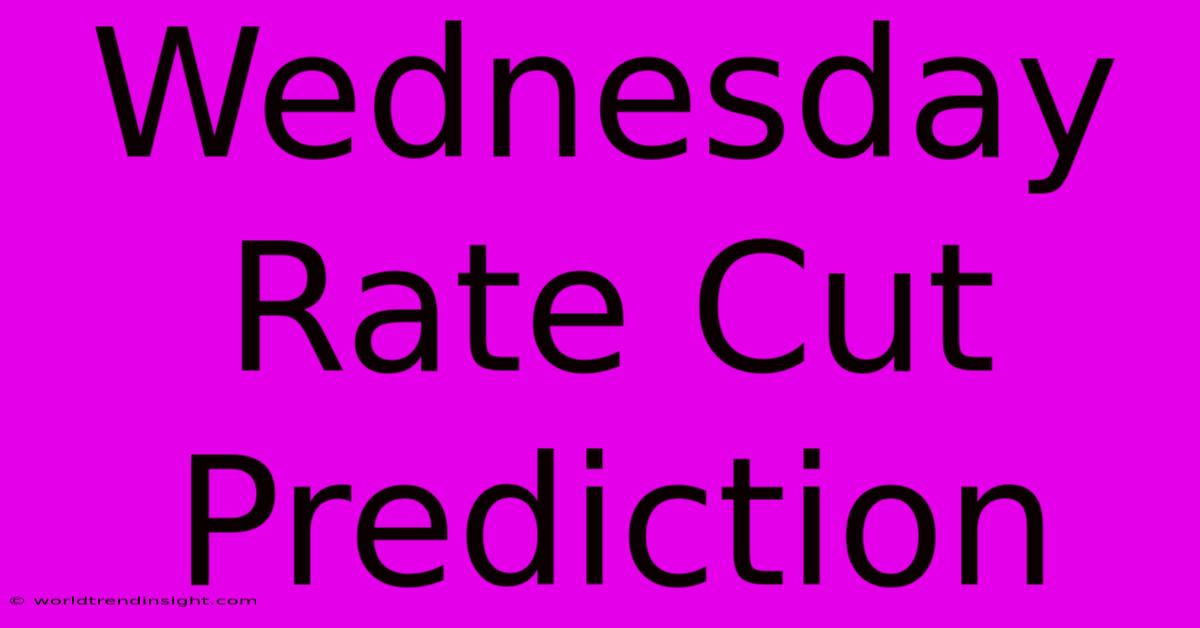Wednesday Rate Cut Prediction

Discover more detailed and exciting information on our website. Click the link below to start your adventure: Visit Best Website Wednesday Rate Cut Prediction. Don't miss out!
Table of Contents
Wednesday Rate Cut Prediction: My Wild Ride with the Fed
Hey everyone, so you're probably here because, like me a few weeks ago, you're freaking out a little about the possibility of a Wednesday rate cut. Am I right? I mean, the whole thing's a rollercoaster, right? One minute you're thinking, "Sweet, lower interest rates!", the next you're wondering if the economy's about to tank. It's enough to make you want to bury your head in the sand.
My Totally Wrong Prediction (and What I Learned)
Let me tell you a story. A few months back, I was sure – absolutely, positively certain – that the Federal Reserve was going to cut rates in September. I’d even written a whole blog post about it, complete with charts and graphs. I was feeling like a financial guru, man. I felt so smart! My predictions were totally on point, or so I thought...
Turns out, I was totally, hilariously wrong. The Fed held steady. My carefully crafted predictions? They were about as useful as a chocolate teapot. My blog post? It aged like milk. Talk about a gut punch. I felt like an idiot. Like, seriously, my ego took a major hit.
But you know what? That experience, as painful as it was, taught me a ton. I'm here to share that knowledge with you, hoping to save you some heartache (and maybe a little embarrassment).
Understanding the Fed's Moves: It Ain't Always Obvious
The thing is, predicting the Fed is a seriously complex business. It's not just about looking at inflation numbers; it's about understanding the entire economic picture, and let me tell you, that's a lot of data to absorb. There are so many factors that influence their decisions – employment rates, consumer confidence, global economic events... The list goes on forever. Honestly, it's like trying to solve a giant, complicated puzzle with pieces that keep changing.
So what did I learn? Well, first off, don't rely on single indicators. Pay attention to the whole economic landscape. Look at the big picture. Consider things like:
- Inflation: Are prices rising too quickly? That's usually a signal for the Fed to act. Pay close attention to the Consumer Price Index (CPI) and the Producer Price Index (PPI).
- Unemployment: A low unemployment rate often suggests a healthy economy, which might discourage rate cuts. Check the monthly employment reports.
- Economic Growth: Look at GDP growth rates. Is the economy expanding at a healthy pace or slowing down?
- Global Economic Conditions: International events can heavily impact the US economy. Stay informed about global news.
Secondly, don't treat predictions as gospel. Even the experts get it wrong sometimes. That's why it's crucial to be flexible in your thinking. Remember my epic fail? It's okay to be wrong; what matters is learning from your mistakes. Always have a plan B (or C).
How to Stay Informed (Without Losing Your Mind)
Staying informed doesn't mean spending all day glued to the news. Find reliable sources— reputable financial news websites, economic journals, and the Federal Reserve's own website— and stick to them. Avoid overly sensationalist blogs or social media posts that might distort the truth, like the ones I almost fell for. Don’t forget to be critical of what you read and cross check information.
The Bottom Line: Be Prepared, Be Flexible, and Don't Panic!
Predicting a Wednesday rate cut is tough – even for the pros. What's important is to understand the factors involved, stay informed, and approach predictions with a healthy dose of skepticism. If the Fed does cut rates this Wednesday, great! If not, don't freak out. Stay informed and adjust your plans accordingly. That’s the best way to navigate this financial wild ride. And hey, at least you'll learn something along the way! Remember that, even with all the information, mistakes are inevitable. It is important to be flexible and prepared for various outcomes.

Thank you for visiting our website wich cover about Wednesday Rate Cut Prediction. We hope the information provided has been useful to you. Feel free to contact us if you have any questions or need further assistance. See you next time and dont miss to bookmark.
Featured Posts
-
Barcelona Vs Brest Predicted Starting Xi
Nov 27, 2024
-
Wednesday Rate Cut Prediction
Nov 27, 2024
-
Champions League Rb Leipzig Lineup Vs Inter Milan
Nov 27, 2024
-
Zimbabwe Vs Pakistan 10 Run Loss
Nov 27, 2024
-
Ac Milan Beats Slovan Bratislava
Nov 27, 2024
